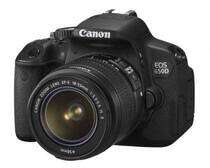Canon EOS 650D review
The Canon EOS 650D was the company's mid-range DSLR release for 2012. Since then it has been superseded twice, first by the Canon 700D in 2013 and then by the Canon 750D in 2015. Canon's camera's don't change radically from model to model, but the latest iteration has a much-improved 24-megapixel sensor, better autofocus with double the number of cross-type points, faster image processing, Wi-Fi & NFC, and much more. That said the 650D still takes some mighty fine pictures, so if you've seen it at a bargain price it's worth considering.
Original review
The 650D might seem pretty a pretty conservative update over the 600D. It looks almost identical, and the key specs – 18-megapixel sensor, 9-point autofocus, 3in articulated screen – haven't changed. However, there are some substantial improvements here, many of which address long-standing criticisms we've levelled at previous models.

Canon has finally ditched the three-year-old DIGIC 4 processor in favour of the DIGIC 5 chip used in various recent PowerShot cameras. This raises continuous speed from 3.7fps to 5fps, and also introduces in-camera chromatic aberration (CA) correction. This eliminates discoloured halos around high-contrast lines, and is something Nikon's SLRs have offered for many years. These twin benefits of the faster processor aren't available at the same time, though. With CA correction enabled, 5fps shooting lasted for just three frames before slowing to 2.1fps. With it disabled, it lasted for 29 frames and then slowed to 3.6fps. It's a shame that CA correction can't be set to switch off automatically when continuous shooting is selected.

5fps shooting with continuous autofocus makes it easier to capture action shots - click to enlarge

In-camera chromatic aberration correction is a big step forward, and really shows in high-contrast shots - click to enlarge
Automatic high dynamic range (HDR) shooting is now available, and has a dedicated position on the mode dial for quick access. Curiously, the camera slightly crops and then enlarges the image back to 18 megapixels. More worryingly, we found that autofocus problems were quite common in this mode. There's also a new Handheld Night Scene, which combines three exposures to reduce noise. It just made things softer at ISO 3200 but proved its worth at ISO 12800.
For us, the 600D's biggest weakness was its slow autofocus in live view mode. Live view on an SLR bypasses the main phase-detect autofocus system, and the 600D's backup contrast-detect system was appalling, taking up to four seconds to lock onto subjects. For the 650D, Canon has integrated additional phase-detect autofocus points onto the sensor. This appeared to improve live view autofocus speeds, but only to an extent – it still took between one and two seconds to focus. That's still likely to be too slow for most people. It's also significantly slower than the Pentax K-30 we're currently mid-way through testing.

The main autofocus system has nine points, but this time they're all cross-type for increased sensitivity. Previously only the centre point was cross-type, which meant we rarely bothered to use the other eight points. However, we experienced the same autofocus reliability issues that we've seen on previous models when using the 18-55mm kit lens.